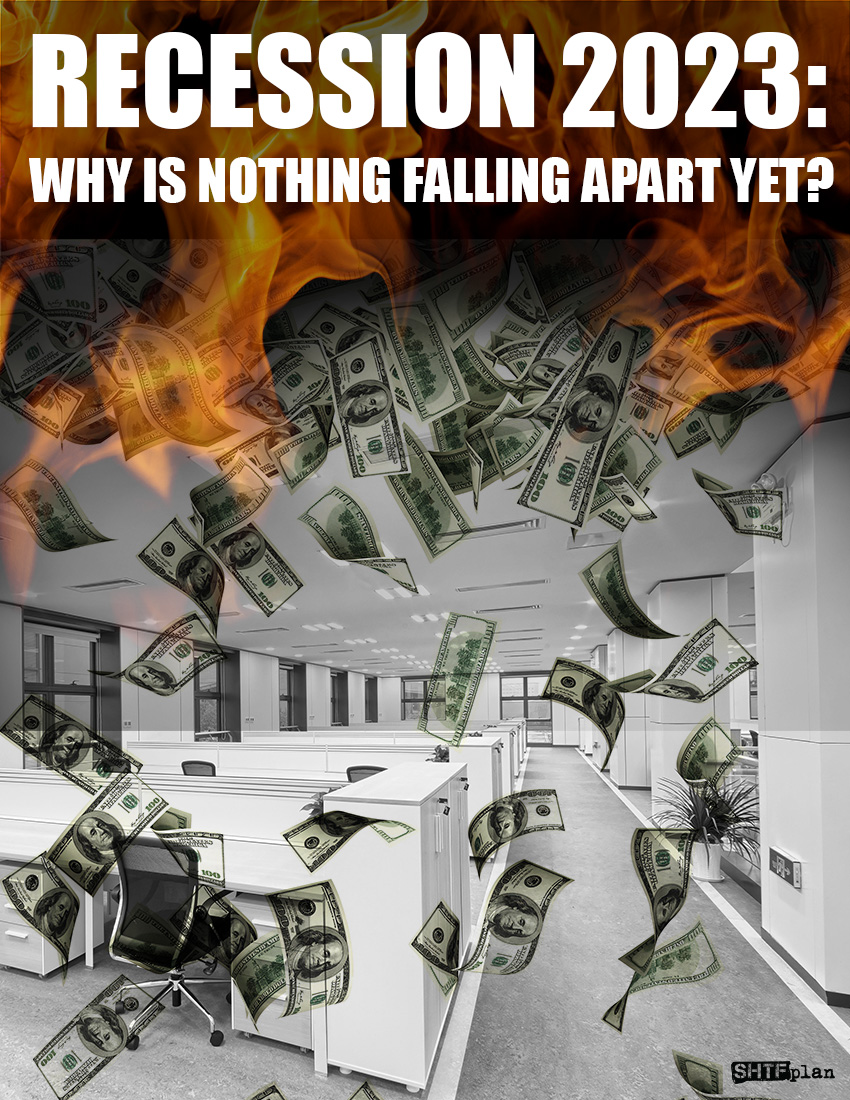
TRUMP SAYS: HUNTER MAKES FORTUNE FROM SHADY DEALS!
BIDEN FAMILY STINKS TO HIGH HEAVENS OF CORRUPTION!
DON'T GET LEFT OUT: HUNTER MUST BE STOPPED!

This article was originally published by Frank Shostak at The Mises Institute.
In the late 1960s, Edmund Phelps and Milton Friedman challenged the popular view that there can be a sustainable trade-off between inflation and unemployment. In fact, over time, according to PF, loose central bank policies set the platform for lower economic growth and a higher rate of inflation, or stagflation.
Starting from a situation of equality between the current and the expected rate of inflation, the central bank decides to boost the rate of economic growth by raising the growth rate of money supply. As a result, a greater supply of money enters the economy and each individual now has more money at his disposal.
Because of this increase, every individual believes he has become wealthier. This raises the demand for goods and services, which in turn sets in motion an increase in the production of goods and services.
All this in turn increases producers’ demand for workers, and subsequently, the unemployment rate falls to below the equilibrium rate, which both Phelps and Friedman labeled as the natural rate. Once the unemployment rate falls below the equilibrium rate this starts to exert an upward pressure on price inflation.
Consequently, individuals come to realize that monetary policy loosened. People begin to understand that their previous increase in money purchasing power is dwindling, so they form higher inflation expectations.
All this diminishes the overall demand for goods and services. A dwindling in overall demand slows down production of goods and services which, in turn, pushes the unemployment rate higher. At this point, we are where we were prior to the central bank’s decision to loosen its monetary stance but with a much higher rate of inflation.
At this point, we have a decline in the production of goods and services, rising unemployment, and an increase in price inflation, or stagflation. From this, PF has concluded that if the increase in the money supply growth rate is unexpected, the central bank can engineer an increase in economic growth.
Once, however, individuals learn about the increase in the money supply and assess the implications of this increase, they adjust their conduct accordingly. Consequently, the boost to the economy from the increase in the money supply growth rate disappears.
In order to overcome this hurdle and strengthen the rate of economic growth, the central bank would have to surprise individuals through a much higher rate of monetary pumping. However, after some time, people will learn about this increase and adjust their conduct accordingly. Consequently, the effect of the higher growth rate of money supply on the economy is likely to vanish again and all that is going to remain is a much higher inflation rate.
From this, Phelps and Friedman concluded that loose monetary policies of the central bank can only temporarily generate economic growth. Over time, however, such policies will cause higher price inflation. Hence, according to Phelps and Friedman, there is no long-term trade-off between inflation and unemployment.
In a market economy, a producer exchanges his product for money and then exchanges the received money for the products of other producers. Alternatively, we can say that an exchange of something for something takes place by means of money.
Things are, however, not quite the same once money is generated out of “thin air” because of loose central bank policies. Once that happens, it enables an exchange of nothing for something, a diversion of wealth from wealth generators to the holders of the newly generated money.
The holder of money out of “thin air” obtains goods without contributing to the pool of consumer goods or to the pool of real savings. This means that real savings are diverted from wealth producers to those money holders. In the process, wealth generators are left with fewer consumer goods at their disposal, which weakens their ability to expand the real economy.
An exchange of nothing for something diverts real savings and will take place regardless of whether the increase in money supply is expected or unexpected. This means that contrary to Phelps and Friedman, even if monetary increases are expected, they will undermine economic growth.
Increases in money supply create exchanges of nothing for something, diverting real savings from wealth generators to non-wealth generators. Consequently, this weakens the real savings formation process and weakens economic growth. Also, note that the price of a good is the amount of money paid for the good, so when this money enters a particular market, more money is paid for the good in this market, increasing the prices of goods.
We then have a situation whereby increases in money supply undermine the process of wealth generation, thus stifling economic growth. At the same time, we have more money per good which increases their prices. Hence, we have both an increase in goods prices and a diminishing of economic growth, which we call stagflation.
Stagflation is the ultimate result of monetary pumping. Therefore, whenever the central bank adopts an easy monetary stance, it also sets stagflation in motion in the months ahead. The fact that over time a strengthening in the monetary growth may not always manifest through a visible stagflation does not refute what we have concluded. What matters for the state of an economy is not the manifestation of stagflation but rather its causes.
The severity of stagflation depends upon the state of the pool of real savings. If this pool is declining, then a visible decline in economic activity will likely ensue. Moreover, on account of past monetary pumping and the consequent increase in price inflation, we will have a visible stagflation. Conversely, if the pool of real savings is still growing, economic activity is likely to follow suit. Given the rising momentum of prices, we will have here positive correlation between economic activity and price inflation. Note that the symptoms of stagflation are not visible here because of a growing pool of real savings. We can conclude that if on account of past monetary pumping, we do not observe the symptoms of stagflation, this raises the likelihood that the pool of real savings is still growing. Conversely, if we can observe the symptoms of stagflation, then most likely the pool of real savings is declining.
Increases in money supply set in motion an exchange of nothing for something. This diverts real savings from wealth generators to non-wealth generators. Consequently, this weakens the wealth-generation process and in turn the pace of economic activity. Now, when money enters goods markets it means that we have more money per good. This means that the price of goods has risen.
Hence, what we have here is an increase in goods prices and a weakening in economic growth. This is what stagflation is all about. We suggest that the outcome of the monetary pumping is always stagflation. It is not always visible, though. As the pool of real savings comes under pressure, the phenomenon of stagflation becomes more visible.

It Took 22 Years to Get to This Point
The health "experts" are "on alert" after the first case of bird flu has been found in a child....
This article was originally published by Jane L. Johnson at The Mises Institute. A quick internet...
Once again, Russia is placing the blame for the Nord Stream pipeline sabotage on the United States...
Commenting Policy:
Some comments on this web site are automatically moderated through our Spam protection systems. Please be patient if your comment isn’t immediately available. We’re not trying to censor you, the system just wants to make sure you’re not a robot posting random spam.
This website thrives because of its community. While we support lively debates and understand that people get excited, frustrated or angry at times, we ask that the conversation remain civil. Racism, to include any religious affiliation, will not be tolerated on this site, including the disparagement of people in the comments section.


Comments